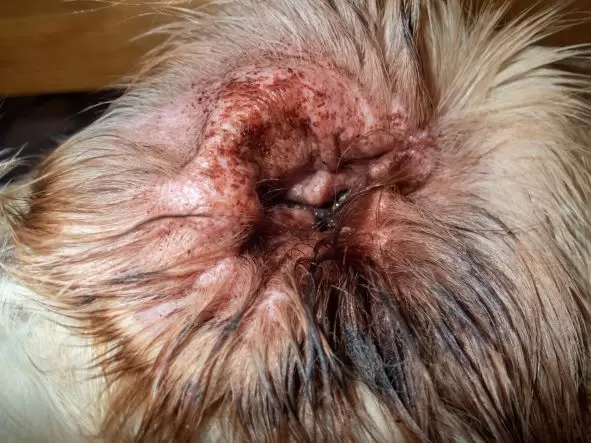Overzicht

General information?
An ear infection is an irritating and painful overgrowth of bacteria or yeasts inside the ear. Most ear infections develop due to an underlying problem such as a skin allergy, ear mites, growths, excessive ear cleaning or wax.
Most ear infections only affect the outer ear canal, but left untreated, an infection can spread deeper down into the middle or inner ear.

What are the symptoms?
Symptoms of an ear infection include:
Middle and inner ear infections also often cause:

Wanneer moet u contact opnemen met uw dierenarts?
Contact your vet for an appointment ASAP if you suspect your dog has an ear infection – it’s a very painful problem that needs prompt treatment. If you notice any signs of a middle or inner ear infection (loss of balance/head tilt), this is more serious and requires a same-day appointment. Be sure to tell your vet if your dog has regular ear infections or has had more than 2-3 in its lifetime.
Behandeling?
Your vet may want to look at a discharge sample from the infected ear to find the cause, and then recommend some of the following:
Important: Never use cotton wool buds to clean your dog’s ears, use cotton wool pads, and don’t push them inside the ear.
Outlook?
If your dog’s ear infection is caught and treated early, it will probably clear up quickly. You will need to take your dog back for a check-up to make sure it has completely resolved.
What if it doesn’t improve?
If your dog’s ear isn’t getting better, your vet may decide to examine or treat it under anesthetic. Some ear infections require several weeks of treatment. In some more severe cases, surgery is necessary because the infection continues for so long that the ear becomes misshapen.
Ongoing care?
Ongoing ear care is important for dogs that suffer from ear infections.
How to clean your dog’s ears?
Watch this video for tips and advice on cleaning your dog’s ears. Remember to use a good quality ear cleaner for dogs.
Kosten?
Ear infections can be expensive to manage, especially if they keep coming back. It’s important to speak to your vet openly about your finances, the cost of treatment, as well as what you think is right for your dog. There may be more than one treatment option, so if one doesn’t work for you and your pet, your vet may be able to offer another.
Het prioriteren van hondenverzekering vanaf het moment dat u uw hondengezel in uw leven brengt, wordt ten zeerste aanbevolen. Deze proactieve aanpak garandeert dat u de essentiële financiële steun hebt die nodig is om aan de gezondheidszorgbehoeften van uw hond te voldoen.

| Koekje | Duur | Beschrijving |
|---|---|---|
| cookielawinfo-checkbox-analytics | 11 maanden | This cookie is set by GDPR Cookie Consent plugin. The cookie is used to store the user consent for the cookies in the category "Analytics". |
| cookielawinfo-checkbox-functioneel | 11 maanden | The cookie is set by GDPR cookie consent to record the user consent for the cookies in the category "Functional". |
| cookielawinfo-checkbox-noodzakelijk | 11 maanden | This cookie is set by GDPR Cookie Consent plugin. The cookies is used to store the user consent for the cookies in the category "Necessary". |
| cookielawinfo-checkbox-anderen | 11 maanden | This cookie is set by GDPR Cookie Consent plugin. The cookie is used to store the user consent for the cookies in the category "Other. |
| cookielawinfo-checkbox-prestaties | 11 maanden | This cookie is set by GDPR Cookie Consent plugin. The cookie is used to store the user consent for the cookies in the category "Performance". |
| bekeken_cookie_beleid | 11 maanden | De cookie wordt ingesteld door de AVG Cookie Consent-plug-in en wordt gebruikt om op te slaan of de gebruiker al dan niet toestemming heeft gegeven voor het gebruik van cookies. Er worden geen persoonlijke gegevens opgeslagen. |
Maak een account aan of log in om huisdieren waarvan u houdt te redden.
Heeft u geen account? Neem contact met ons op
Voordat u doorgaat met uw adoptieaanvraag, dient u onze gegevensverwerkingspraktijken te lezen en te accepteren:
Opmerking: By clicking "I Agree & Continue", you will be redirected to an external application form. This tracking system logs your interest but does not capture data from the external form.
Maak een account aan of log in om huisdieren waarvan u houdt te redden.
Heeft u geen account? Neem contact met ons op
Voordat u doorgaat met uw adoptieaanvraag, dient u onze gegevensverwerkingspraktijken te lezen en te accepteren:
Opmerking: By clicking "I Agree & Continue", you will be redirected to an external application form. This tracking system logs your interest but does not capture data from the external form.